Company of Heroes 3 Review
A new theater of a familiar war
The real-time strategy genre is certainly not as widespread as it used to be. While we get the occasional reboot or new IP, the scene has been mostly dormant following its "golden era" over a decade ago. While some franchises such as StarCraft and Age of Empires try to remain alive with updates or even a new entry, others like Command & Conquer have largely fallen off. Developer Relic Entertainment managed to carve out their piece of the RTS space with their unique Company of Heroes franchise. It began back in 2006, and was followed up with a successful sequel. What's most impressive is that Company of Heroes 2 has managed to maintain an incredibly steady player base since it launched a decade ago, and eight years since its last expansion pack. With Company of Heroes 3, the developers chose to stick with their successful formula, but some dents in the armor prevent it from reaching the same heights as its predecessor, at least at launch.
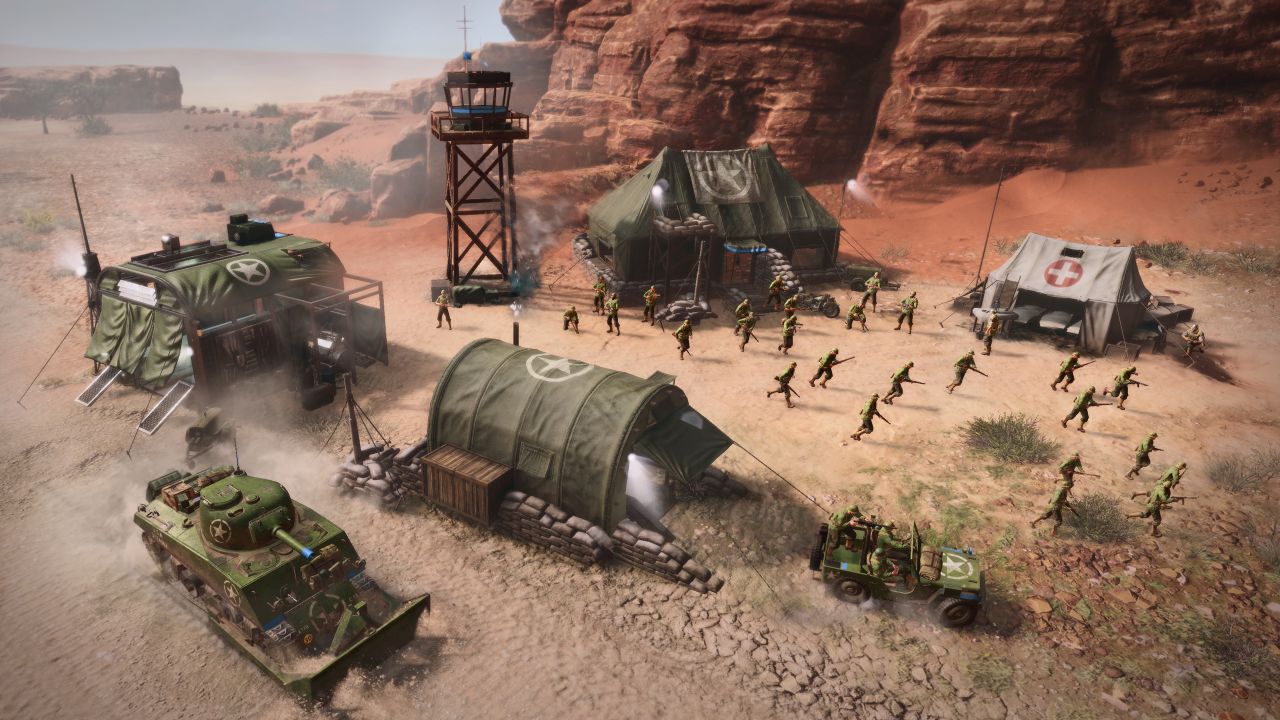
Just like the rest of the franchise, the latest entry is set during World War II. After COH2's Eastern Front setting with Soviet Red Army and Wehrmacht, COH3 switches to Italian and North African theaters of war and features four factions: Allied British and US Forces, and Axis Wehrmacht and Afrikakorps. Three of these factions are returning from the previous game, as they were added in post-launch expansion packs, so fans should be familiar with some of their units and intricacies. Still, there are plenty of gameplay changes so the initial familiarity is not giving you much of an advantage, and it's nice to have four factions at launch.
To get familiar with the mechanics and most of the factions, you can delve into the single player campaigns. The North African Operation is a more traditional experience, where you guide the German Afrikakorps through a series of linear missions. This campaign is only about 4-5 hours long and is mostly focused on unique combat scenarios, without much time spent base-building. The second option is the Italian dynamic campaign, which sees you control the Allies as they fight through the country, trying to reach Rome. This sandbox, turn-based Total War / Civilization style campaign has tons of missions to undertake, including optional objectives, and initially appears to have lots of depth and replayability, but it turns out to be a fairly dull affair with most of its 12+ hours constantly struggling with pacing. Further, it seems that the final 3-4 hours of the Italian campaign has the most bugs and crashes, as up until then the game runs without any issues.
During the Italian campaign, you will manage a few different units as they travel across the map and take on various objectives, engage in combat, and establish supply lines. The initial design seems engaging – it's got all the foundations of a meta-campaign, including enemy units to fight and cities to take over, new missions that constantly pop up, all while you try to please three different faction commanders to earn their passive bonuses and make occasional choices. In reality, however, progress often grinds to a halt due to many strange design choices, and its many mechanics turn out to be quite shallow and easily ignored or manipulated.
Progress is often slow because you can only take so many actions during your turn with a given unit. Movement distance is decent, but executing an attack on an enemy or city spends all your action points, regardless of how many you had. You can do things like bombard city defences from ships that sit on the coast, but that requires resources which are earned slowly and only with the next turn. And when your turn is done, you have to sit and wait as the enemy AI does pretty much nothing – they move around, sometimes attack your units, but mostly just send recon flights that don't accomplish anything. The enemy AI in the dynamic campaign is extremely basic and watching their turns further slows the pacing.
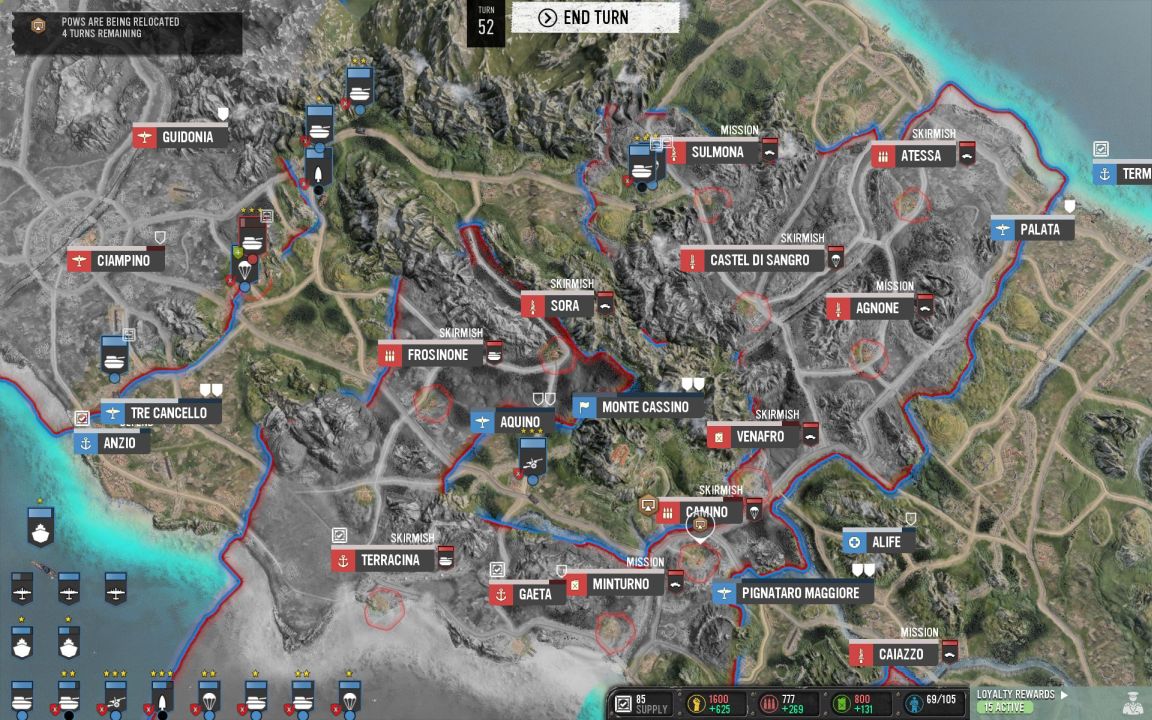
Management of your own army is easy. They can be healed, easily upgraded to increase their firepower and thankfully you can automatically resolve random open-map encounters with enemies (just so you can keep the campaign moving along). As your units earn experience, you can unlock more troop types to deploy during the RTS battles and get various passive bonuses like extra combat effectiveness or resources. It's easy to forget and ignore trying to earn passive bonuses from the three friendly commanders. But while that may make it seem like there's a lot going on, the truth is that most battles are decided in the RTS mode anyway, and the meta-campaign just feels like a slog. Not to mention, the story is weak and has a terrible ending.
But if there is one redeeming factor in the campaigns, it's the scripted mission scenarios. During these RTS battles, you will see a lot of quite well designed original maps and unique encounters, tapping into the core mechanics that make this franchise so enjoyable. You could be defending strategic points in the field, trying to survive until reinforcements come, or making your way through densely packed urban streets. All of the campaign missions are interesting to play through and they actually often avoid the cliché of building up your forces from a base and marching them across the map. Even when you get a few generic skirmishes (non-story missions), the objectives can vary, such as having to control three central key points (like in multiplayer), trying to take control of the whole map, or simply outlasting the enemy.
The strong mission design is supported by the still-great underlying RTS gameplay that Company of Heroes is known for. While there have been attempts to imitate it, such as with Iron Harvest last year, none have managed to do so. The basics remain the same and will be familiar to returning fans – you have a base like any RTS, and the goal is to take control of sectors on the map in order to increase your resource flow, and hold three central strategic points to drain the enemy's Victory tickets. The resources include manpower, munitions, and fuel, and these allow you to produce new units. You gradually add new buildings to your base in order to be able to create new unit types.
The four included factions seem to be decently balanced, though of course there will need to be tweaking over time. Though three of four are returning from COH2 and some units and abilities will be familiar, new options have been added and the flow of unit upgrades has been redone. The US Forces have their foundation in infantry, with larger squads, many unit options, and lots of equipment and upgrades. Their counterpart are the Wehrmacht, who also focus on infantry but have smaller and more deadly squads with different upgrade paths. The British are not the defensive-focused army COH2 fans will remember, though they still prefer longer-range encounters with fewer infantry options and quicker access to MGs and Mortar teams. Lastly, the Axis Afrikakorps are a very interesting new faction that's vehicle focused and has a few units from COH2's Oberkommando West. They can produce long range anti-infantry weaponry, paradrop, and overwhelm with light vehicles and tanks – they even have a recovery unit that (slowly) lets you bring back to life any destroyed vehicle on the field of battle.
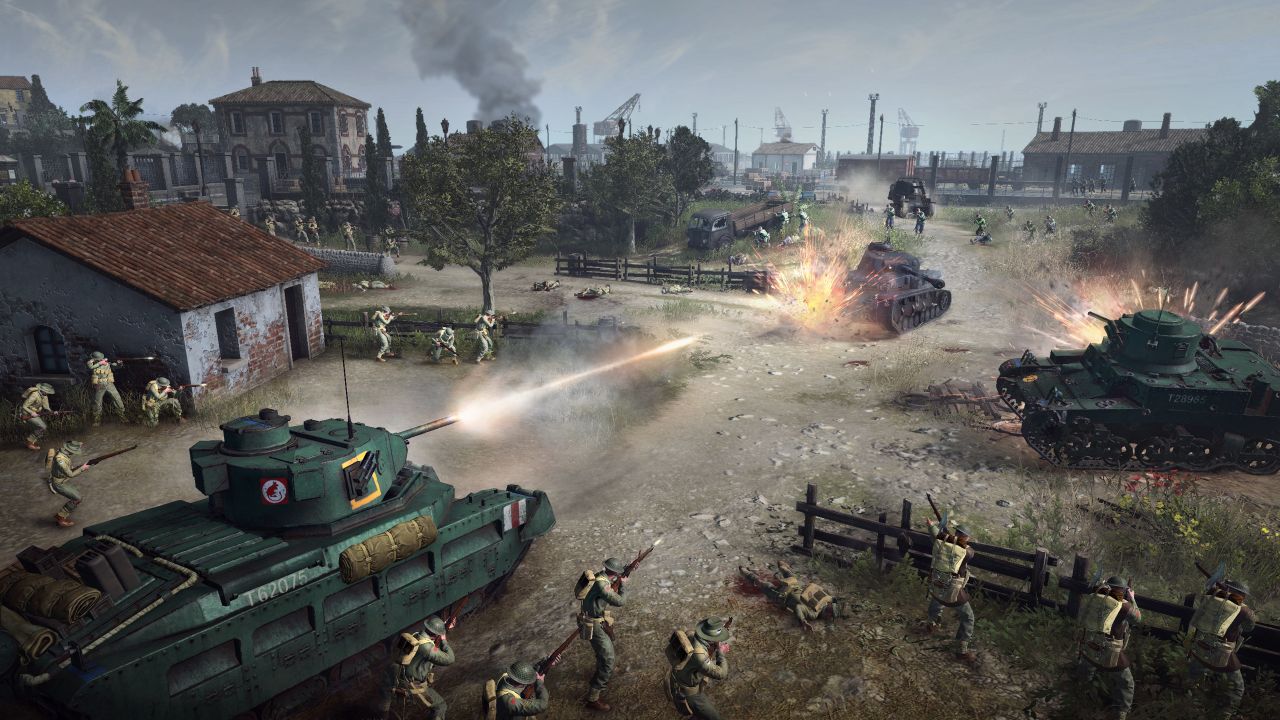
The unit management remains unique, in that squads are composed of multiple individual members. So your riflemen could lose some men but keep fighting, and your MG squad will rotate a new gunner if the previous one is killed. As you lose members of a unit, they can retreat to the base and reinforced, to keep their experience gain and fight another day. The same basic three star experience system unlocks passive bonuses and thus strongly encourages unit preservation.
Units can also gain new active abilities – and new to COH 3 is having a choice for some units on which ability to unlock. Another big change is that reinforcements can now be done automatically, so there is less micromanagement to click and reinforce all your retreated units at the base. And speaking of the base, there is no longer a need for an engineer type unit to construct buildings, that's done automatically, letting you put all forces on the front lines. Elevation changes are now an additional advantage to consider, and being able to retreat directly out of buildings without having to exit them first is a welcome change as well. Another new element to the franchise – though certainly not RTS games – is a building that lets you research upgrades for your entire army, instead of buffing individual units (which you still do plenty of, by purchasing new weapons for example).
Another big change is how the call-ins are handled. Before the match, players can equip three different battlegroups that offer special call-in abilities (such as recon flights, new unit deployments, or artillery barrages) or passive boosts. In COH2, these abilities unlock overtime in a linear fashion, but in COH3 it’s another decision point to think about. First you choose from one of the three, but within each there are two mini-trees where you can make decisions on which ability to unlock. It adds more flexibility depending on how things are going, but it's also something new to think about and remember to spend your points. The game does have helpful audio cues for when you have points or resources that are accumulating.
Using the environment and cover remains an extremely important factor. Putting units into buildings or behind sandbags gives them great advantages – as long as they do not get flanked. Units in buildings can be formidable to remove, but they need to watch out for artillery, flamethrowers, or new US forces’ ability to breach inside. Units facing off against and MG will get suppressed and become useless, but having a mortar to back them up can dislodge the emplacements. Smart unit management, combined assault forces, and strategic positioning makes for some highly engaging and tense RTS gameplay, which remains unique to the franchise and is as good in the third entry as always.
It also remains a game where player precision and speed is not as critical as some other RTS games, thanks to the realistic design of unit behaviour. Any action you issue to your units usually takes a few moments – throwing a grenade or repositioning your machine gun, or having the turret turn on your tank. Timing can be a blessing and a curse, but with some grenade timers now being a little longer than COH2, players get more time to react and get out of the way. Still, there's the element of luck and randomization that can be thrilling and frustrating. Two units shooting at each other won't always have the same outcome, and a mortar shell can either do little damage or have devastating impact. Having your AT gun miss a critical shot on an enemy tank (who now have separate side armor ratings) and subsequently get blown up by a random artillery hit is a unique experience that will get your heart racing like few RTS games out there.
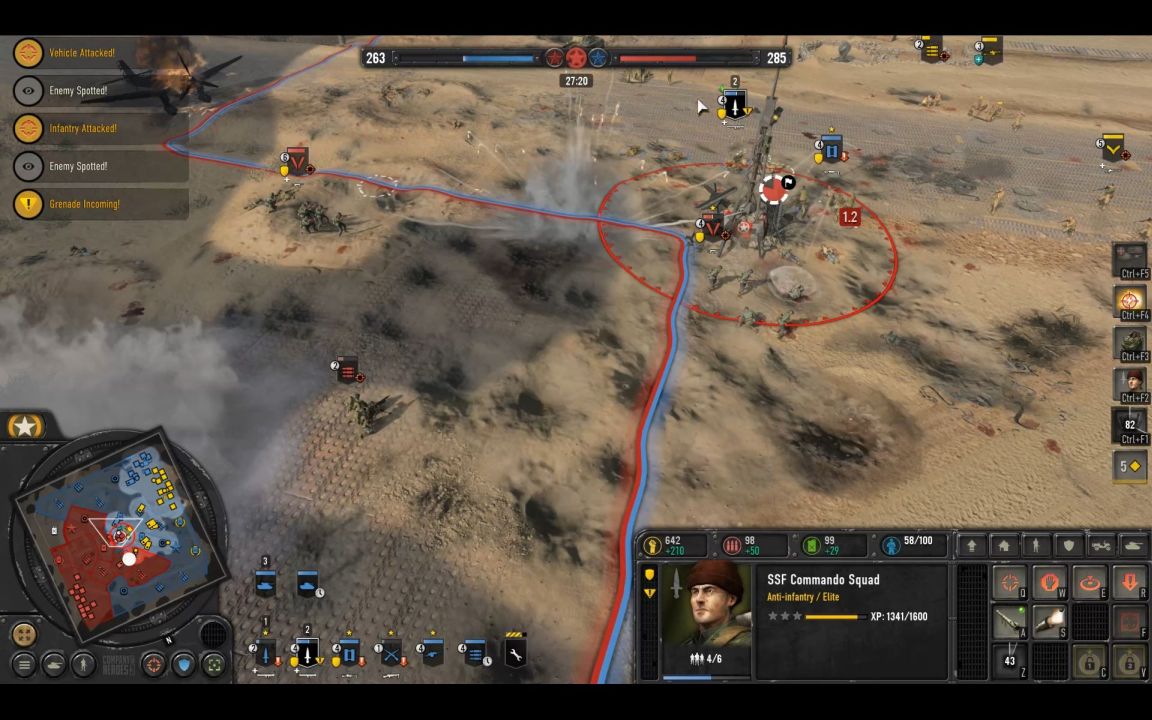
The more realistic source of frustration comes from some of the lack of polish in gameplay. Pathfinding has been streamlined thanks to new auto-vaulting mechanic, but at the same time there are too-frequent instances of units getting stuck, which annoys in solo play and can be devastating online. Adjusting the facing direction of units and vehicles can be awkward and feel unresponsive, or result in your light vehicles spinning in circles trying to reposition. Vehicles can no longer run over enemies or destroy structures, which some may see as a step back and a reduction of your strategic battle options. In some cases, instead of throwing a grenade, the animation does not trigger and instead sees a member of the squad run up to the enemy, causing glitches for managing that squad. When moving a group of multiple units, adjusting them for cover is tough and tweaking their facing direction even more so as those UI elements have been removed. While these issues are not game breaking, they further agitate if you're having a tough battle and the existing luck elements haven't been going your way.
The tensest battles are likely going to happen in multiplayer, which seems to work well connectivity wise. You can warm up with co-op skirmishes against AI, though there is strangely no option to set the difficulty - but if you do play against the CPU in custom modes or offline you'll notice many good improvements to their battle behaviour and strategy on higher difficulties. You can do so in custom matches, at least. Playing against others works well and can result in great 40+ minute battles of attrition, even though the developers have adjusted things to make most matches be shorter. There also seems to be a renewed emphasis on the mid-game, with light vehicles taking on a much more visible role compared to COH2. There are around five 1v1 maps, four for 2v2s, three for 3v3s and two 4v4s maps, which seems like a decent lineup. Only unranked play is currently available, and it's tough to say if skill based matchmaking is involved, as you could go from a heavy defeat to a quick victory back to back.
Problems in multiplayer really arise more from the lack of polish and quality-of-life features. For instance, there is no option to surrender, and all enemy and friendly units appear the same red/yellow color and do not have the player's name like in COH2, so you cannot coordinate or see if you're fighting more than one enemy player at the same time. Everyone has the same player icon and banner, which looks strange and there seems to be no way to adjust it. There is a separate friends system that seems unnecessary given the game requires Steam to play. The variety is also lacking a bit – the current three battlegroups for each faction is all you get; compare that to tons of commander choices in COH2, and things may feel a bit stale. There is an in-game store, which is not open at launch, but presumably that's where new visual skins and battlegroups will be made available in the future. One of COH2's main annoyances was that the commanders/battlegroups were purchasable with real money or in-game currency which took forever to acquire, and hopefully the new game won’t follow that model. Last but not least is the camera, which has a very low maximum zoom-out level, making for some frustrating moments where you do not have the visibility to make important movement decisions.
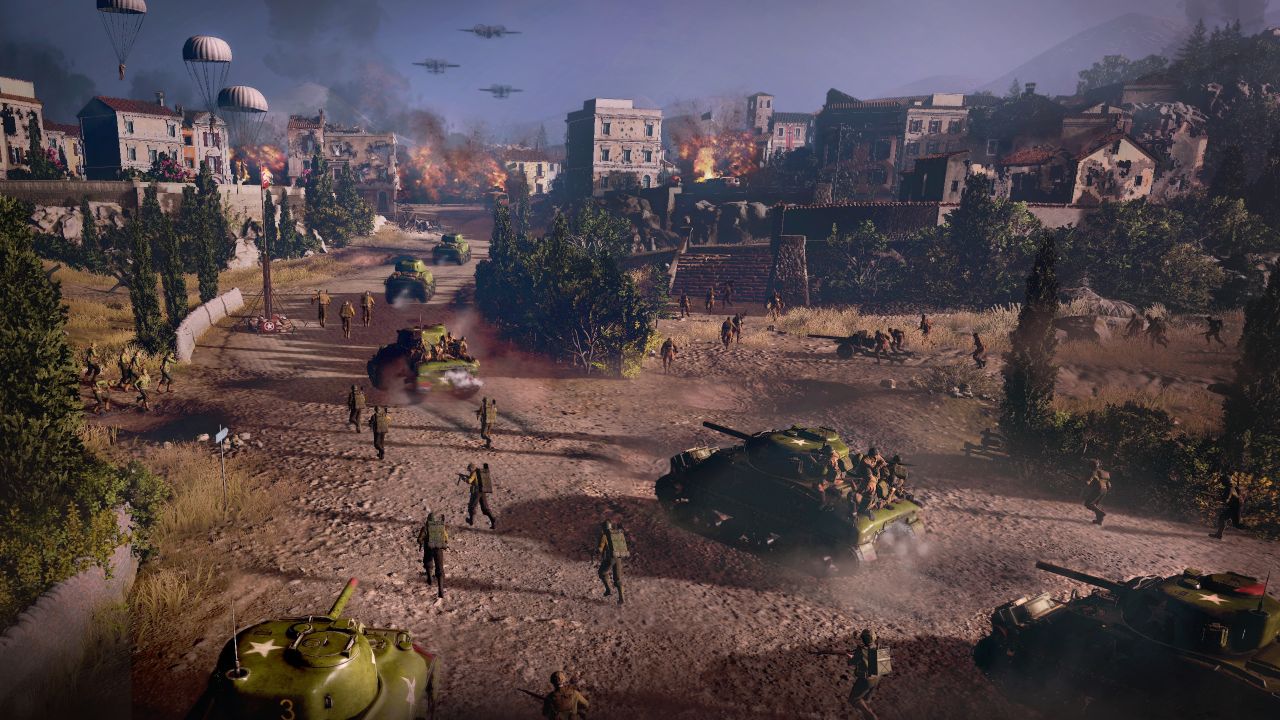
Another problem area actually spans the whole experience – and that is the UI and presentation. The menus are just extremely clunky and outdated, and feel like a beta thrown together really quickly. From the post-game information screens to the in-match UI, everything just looks extremely basic and drab. In-game, the environments and units look not much better than COH2, a game that is a decade old. Sure, some of the special effects are great, such as explosions scattering debris and artillery shells blowing up chunks of sand dunes, but on the whole there's not much here that impresses visually. The level of detail for the units is not much better, and their animations sometimes fail to trigger. It doesn’t look poor, but it's hardly a step up from COH2, and perhaps the only upside here is that the game runs very well given its undemanding visuals. The audio design has been equally subdued, with a different style to the gunfire and explosions resulting in a much less impactful experience. It's perhaps more realistic, but it certainly drains the immersion from combat, and hearing a generic rattle in the distance grows old quickly. Still, at least elsewhere the unit voice dialogue remains very good and immersive.
Company of Heroes 3 is a sequel long in the making, and while it continues to deliver on the excellent core RTS gameplay, and offers more content at launch, it has its own share of problems. The single player campaigns are enjoyable when you are fighting through many original scenarios, but the pacing and poor AI of the Italian meta-campaign weighs it down. The RTS gameplay remains excellent with four factions that offer differing experiences, with tons of changes to separate it from its predecessor and streamline the combat, while offering more options to how you play. Multiplayer is also stable and can offer great thrills. Still, there are issues that need working out – from the occasional gameplay glitches to the terrible UI and returning problems like unit pathfinding that COH2 managed to solve long ago. The underwhelming presentation may not offer as much of a leap as some fans have hoped for, but at least unlike the Dawn of War franchise, Relic have decided to stick with their formula and add onto it with positive results. Newcomers and fans of RTS games should absolutely give Company of Heroes 3 a look for its unique gameplay alone, and while returning enthusiasts (like this reviewer with over 1k hours in COH2) will find plenty of faults, they too may eventually come around, if only after a few months and several patches.
 Comments
Comments




















